It’s a blustery October evening and I’m walking through the centre of Manchester with the team behind Penny Thoughts, an arts zine which gets distributed for free around the city.
Finally, we arrive at our destination: The Partisan Collective, a community space housed within a building at Cheetham Hill which has a slightly faded grandeur to it.
They take me upstairs to a room filled with mismatched furniture and arts and crafts paraphernalia which has a homely feel to it. I’m here to watch the printing process of Penny Thoughts.
The zine is printed using a Risograph printer, hidden away in a corner at Partisan. Risograph printers were originally produced in Japan in the 1980s and provided a cheap and effective way of mass printing.
The machines use soy-based inks and they don’t require the heat process featured in ink jet printers. A Risograph printer can produce copies at fast speeds, around 150 pages per minute.
Rory Spencer and Eva Gerretsen from Penny Thoughts are talking me through the process. We’re joined by Dylan James who is here for a new project they’re launching.
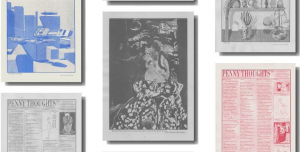 Various Penny Thoughts issues (image courtesy of Penny Thoughts, with thanks)
Various Penny Thoughts issues (image courtesy of Penny Thoughts, with thanks)
It’s the final stages before printing Penny Thoughts; masters are being checked, text is being read through and I’m intrigued to see what the whole process entails.
“The thing that’s so nice about Riso is its lovely grain texture, that’s one of the reasons we use it,” Eva explains. “It’s also cheaper than normal printing, and better for the environment. We use recycled paper, so it has a nice off-white colour.”
Penny thoughts is a double-sided piece of A4. It’s made with two masters, one for the ‘cover’ and one for the content page, which features poems, artwork and short stories submitted by anyone.
The finished zine gets handed out around the city and can be found in places all over the Northern Quarter. There’s an email address on it where people can send in their creations.
“We’re getting submissions from people who have found it in weird spots and the form itself has become something that determines the content,” Eva tells me. “We’ve had people messaging in saying ‘Here’s a thought’, the fact that the kind of submission Penny thoughts has created is a thought.”
Using Risograph printing in Penny Thoughts adds another layer to it; the style is synonymous with DIY zine culture, as Rory describes.
“Riso was something that was invented for mass volume, a lot of political parties used it to make flyers cheaply and quickly a lot of revolutionary movements used it.
“Friends of ours at a collective called Shy Bairns – their current Riso is from the Iraq War and it’s probably still got sand in it.
“A lot of artists find it really quick and stylish way to make their printed matter stand out. You walk through town and you go past the flyer bit in the bar, it’s all the same texture and coated in plastic, your eye glosses over it as easily as rain falls off it, so that’s why people choose Riso.”
The last checks are being made before the issue is sent to print, but why go to so much effort to produce something printed in the digital age?
“It really doesn’t take long to interact with one of these publications, when you sit down to read it, you’re forcing yourself to just pause, even for five minutes, to consume something, or to engage with something that’s not on the internet, yeah, I feel very passionately for it,” Rory tells me, heading towards the printer. “I think we’re ready to print Penny Thoughts.”
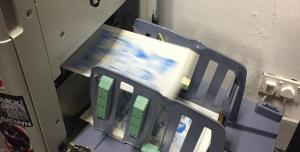 TEMPERAMENTAL PROCESS: The Risograph printer in action
TEMPERAMENTAL PROCESS: The Risograph printer in action
We’re huddled round the printer and I must admit it’s a slightly underwhelming experience. It looks like an ordinary photocopier, just covered in stickers hinting at its role in underground arts culture.
The Risograph whirrs to life with beeps, hums and chirps and after a few minutes it starts spitting out the latest edition of Penny Thoughts.
Rory catches a copy as he and Eva check the quality of the print.
“It’s a temperamental process,” he says.
“A lot of what people send inevitably comes up a bit different in print, because it’s a bit smaller and it’s blue, so sometimes our decision making process as to what goes in is purely ‘Does it work in print?’,” Eva reveals.
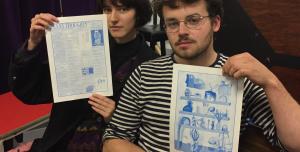 DOES IT WORK IN PRINT? Eva and Rory with issue 28 of Penny Thoughts
DOES IT WORK IN PRINT? Eva and Rory with issue 28 of Penny Thoughts
Once all the copies of Penny Thoughts have been printed it’s time for a new zine to be made: The A4 Project.
Dylan James is here as part of Penny Thought’s new project, Snitch Publishing.
“Dylan emailed us and said ‘I like what you’re doing with Penny Thoughts, I want to set up my own publication’,” Rory explains.
“We want to facilitate that just as much as we are producing our publication. We want to make the arts as accessible as possible in Manchester and this is one way to do it.”
The A4 project is a zine that features an image and a piece of writing also printed using Risograph. The satisfaction of using print and producing something that is physical is what appeals to Dylan.
“By having something tangible, it’s almost like a kind of proudness you get, not in a vain way, but as human beings we tend to like doing things with our hands, building, making tools, and it kind of comes into that very similar way of thinking.”
But Risograph doesn’t just play a role in DIY zine culture in Manchester. I spoke with Caitlin Akers, an artist who uses Risograph printing in her artwork and who works as a technician in the book binding workshop at the Manchester School of Art.
About six years ago the graphic design course bought a Risograph printer and it was moved into Caitlin’s workshop, which is when she fell in love with Risograph printing.
“The [printer] we’ve had in the workshop is brilliant because it’s brought a lot of people together, a lot of students have collaborated on magazines, fanzines. They’ve been able to create posters for events they’ve been putting on, like parties and exhibitions,” Caitlin reveals.
“When they come in and use the printer in the workshop it means they can play around with things and experiment with colours, it’s much nicer to do that especially if you’re an art student and you want to try those things.”
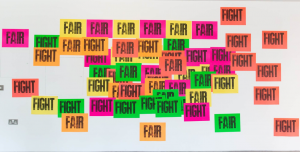 Fair Fight, Caitlin Akers (image courtesy of Caitlin Akers, with thanks)
Fair Fight, Caitlin Akers (image courtesy of Caitlin Akers, with thanks)
As well as helping students with Risograph printing, Caitlin has used it in her own work.
“I did a masters in book arts in Camberwell [College of Arts] and graduated in 2018. My final piece was a big Risograph printed piece. It was a colour separation piece and it was of the interior of a boxing gym in Salford that’s in an old cotton mill.
“When it came out the print colours were just amazing, they don’t look like anything else. They’re very vibrant especially if you’re printing with the fluorescent colours.
“I think with digital print now it can be not that great quality and sometimes the colours can look a bit faded, but with this type of printing, your blacks are very, very black, because you’re using proper wet ink, so the colours come out brilliant.
“It was one image that I had made up into lots of separate prints, so it took a long time to print but it did look pretty cool in the end, I was so pleased with it.”
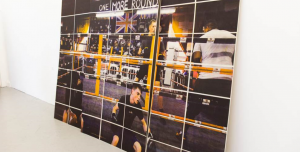 One More Round, Caitlin Akers (image courtesy of Caitlin Akers, with thanks)
One More Round, Caitlin Akers (image courtesy of Caitlin Akers, with thanks)
Caitlin is planning on organising a Risograph workshop at the b-side festival in Portland, Dorset, in September after she produced a Risograph printed poster for their last festival in 2018.
“A lot of people asked me about the print process and I said I did it with a Risograph printer and none of the had really heard of one before, or see one, so I thought, ‘Why don’t we bring one to the island?’ We can set it up and over the course of the festival we can do workshops to show people how to use it.
“After the festival they can just keep the machine as a sort of legacy of the project, and it can be used by community groups, local artists, poets, whoever wants to print stuff. It should be really exciting.”
Risograph printing gives anybody access to a multifaceted process; you can design your own images, write poetry or stories and create events, and then put all of this into creating the Risograph print, which in itself is a work of art. Risograph allows people to share their creativity.
“It definitely seems to be for those kind of people who are interested in community projects, a slightly more conscious [approach to] printing. I suppose the thing with print, whatever form it’s taken, even when it was letter press printing, old newspapers, I think it’s always had a bit of a radical feel to it because print is always such a democratic thing.
“If you make up a screen or a master, you always end up having to print a lot of one thing, it means a lot of people get those prints and it’s always cheap, it’s always been this democratic thing and Risograph embodies that well.”
As our conversation draws to a close, Caitlin references a quote by AJ Liebling: “Freedom of the press belongs to the man who owns one.”
Caitlin adds: “If you have something like a Risograph, which is cheap, then you can spread your word – I just think that’s a really cool and powerful sentiment.”
You can submit your Penny Thoughts to: [email protected] and your short stories to [email protected]



